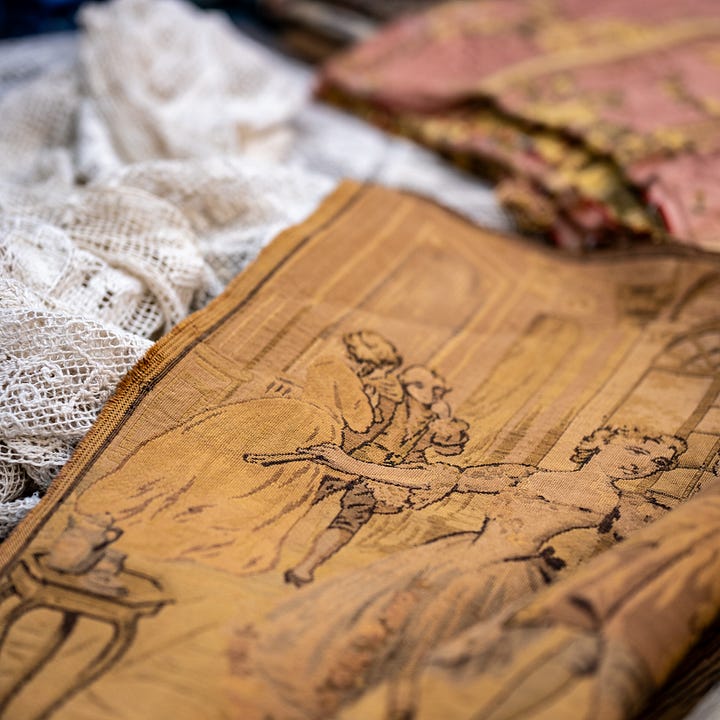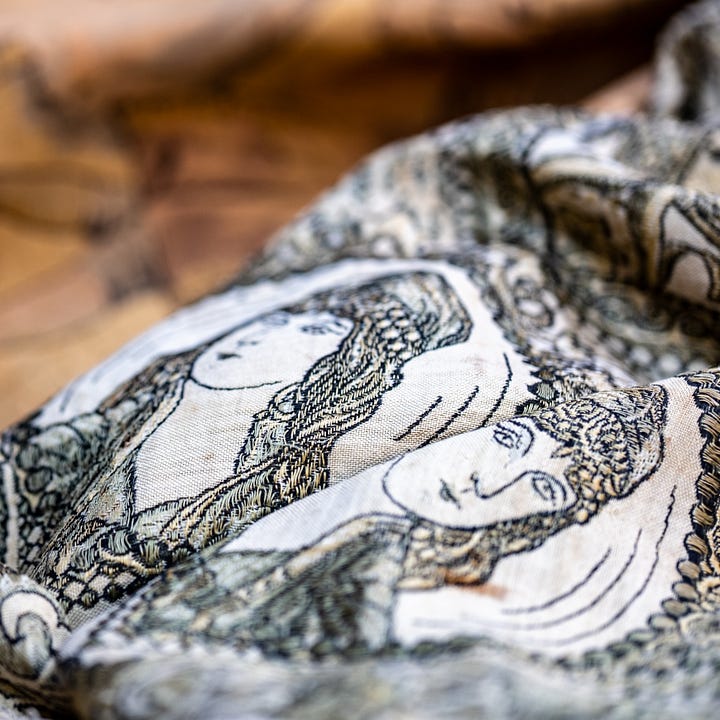dress/code with Anastassia Gonye
"I was making things out of other things all my life. Before we even knew the word 'upcycled.'"
In this edition of dress/code, designer Anastassia Gonye talks about growing up in a family of creators in Moscow, shares the underground reseller culture of the Bins, and explains the dark fairytale energy infusing her designs.
Anastassia Gonye is the designer and artist behind Kookooshka Studio, a Maine based, zero-waste brand using recycled vintage, antique, and modern textiles, as well as deadstock materials, to create 1-of-1 wearables. We met in July, at her 1900’s farmhouse in Buxton, Maine. The day started with a tour of Anastassia’s space, including a sewing room, a textiles studio, and a barn storing rolls of bulk fabric.
Over coffee she took me through a selection of jackets she’d pulled for our interview, talking me through the elements of each design. We stopped on a jacket that was the color of a faded chore coat, a dusty brown canvas with a torn Carhartt pocket as one of the chest panels. On the opposite panel was a traditional embroidery stitch sampler, which ended in a date: May 28th, 1988. This was my parent’s wedding date. When I told Anastassia, she said, “You have to have this jacket. It's yours.”
This moment captures why Kookooshka pieces are so treasured by their owners. Each one of her garments speaks to somebody in exactly the way that this one spoke to me. Every jacket, each with it’s own hidden meaning, waits to be unearthed by just the right person.
On the creative process
“People like interesting garments, because everybody's just wearing the same thing. I think that's what really attracts someone to one of my jackets.”
The individuality in each of your piece’s is kind of like the calling card of your brand. No two are the same. Can you talk about your design process?
Usually I get inspired by one piece of textile, like a needlepoint or an interesting graphic, and I'll take it as a magnet that attracts other textiles to it. Even before I cut, it takes me a while to make each [textile] “nest”. That’s the most fun, pulling pieces like a bird making a nest — a feather here, a twig there — that's me when I’m designing a new piece. I have an idea and I execute it.
I like to have cohesiveness throughout the garment, where even the lining is part of the story. Of course, I’m mixing things randomly, but then you'll meet the person who, that's their thing. Like the jacket you were looking at, with the date of your parents’ wedding, like how random is that? Each person immediately gravitates towards their piece.
People like interesting garments, because everybody's just wearing the same thing. I think that's what really attracts someone to one of my jackets. Every time I do a show there's always new experiments and that's what keeps customers coming and working with me, because they see new things. It can be tedious, because although it seems spontaneous, I finish every piece, completely clean. It's a properly finished garment, but I do fool around with it quite a bit. For example, I’m always experimenting with pockets. Each garment has different pockets, none are the same because I cut them all by hand.
There are lots of vintage textiles in your work, but you also do pieces where you've created your own creatures. Where did these creatures come from?
I loved dark fairy tales growing up, like Hans Christian Andersen and Brothers Grimm, all those strange Victorian fairy tales — the spooky ones. I love Edward Gorey. I love Miyazaki’s Spirited Away.
For my creations, even if it's a mushroom, it's a creature. Everybody gets a face. And they hardly ever smile. They're always stoic or grumpy.
I had a sweater series called “soft animals with sharp objects”. It was usually something sweet like a cuddly bunny, but it would have a mischievous face with little fangs. Sometimes the fangs had blood. Or it would be holding a knife or scissors — you know, sharp objects.
That’s sort of my style, I never make the creatures over-the-top happy. There's never smiles. You don't know if it's a boy or a girl, it's just a little monster. I spend quality time with each one. It's all hand-stitched, and hand-felted. Sometimes one creature will take me a week, working every day.
On being a zero-waste designer
I grew up in Moscow, in communism, so we didn't have anything. I was making things out of other things all my life. Before we even knew the word “upcycled”. [laughs]
My mother was an embroidery designer for big fashion houses, and my grandmother worked in theatre as a costume designer. They knew their way with fabric, but you could barely even buy anything at that time. I remember I needed something flashy for a piano rehearsal, so they took a satin lining out of a vintage coat to make me this concert blouse. It was so beautiful, very elegant, very pretty — but again, making it out of necessity.
So for me, upcycling is sort of like second nature.
Vintage and secondhand pieces are at the core of your designs. You said you spend a lot of time at the Bins [Goodwill by the Pound]. Can you talk about Bin culture and why this part is so important to the process.
“I'm everybody's best friend because I'm not competing for Gucci and Louis Vuitton. I like beat-up things. I like things for their character, with wear and patina.”


So I discovered the Bins when I moved to Maine. I'd never laid my eyes on anything like it. I remember the first thing I did was like the biggest no-no. When you first walk in, that's where you donate; I had no idea. I just dove right in. I’m looking through the freshly dropped stuff, pulling out like mink coats and stuff. I'm so excited like, why is nobody else going for this? What's wrong with these people! I was thrilled.
So yeah, I was escorted out of there. [laughs] That’s how it all started, and it was so much fun. What's great for me is that, normally, nobody's looking for things that I'm looking for. I like beat-up things. I like things for their character, with wear and patina.
At the Bins it’s mostly vintage resellers, so they’re looking for brands names, things that can be resold. Me, I'm looking for granddaddy pants, like Wrangler and Lees — robust, thick denim, anywhere from the 70s to early 2000s. The bigger the better.
I get tons of cashmere because people get one little hole and it’s out. I usually take them apart anyways; I’ll make one sweater out of two or three different sweaters. I also use them for appliques. So I’ll cut them into shapes or faces. I love cashmere because it doesn't unravel; it's heaven to work with. I also score a lot of blankets and quilts, home goods, and tapestries. You saw those batiks, I mean, how fabulous. And nobody else wants them.
I'm everybody's best friend because I'm not competing for Gucci and Louis Vuitton. I love the culture, and I'm a regular now. I’ve been going for two years and I go down once a week — if I'm lucky, I'll go twice. At this point I'm very picky because I have so much already, but it's addictive, of course, because it's always a surprise.
I think that’s part of what makes the Common Ground capsule so meaningful. Everything's sourced right here in Maine, from pieces that are headed to a landfill.
I know this will be your first year selling at Common Ground, can you share a bit about the collection you're creating around the vintage fair art?
I'm hoping to get maybe 30 pieces, enough to build a solid capsule. I have [vintage] aprons and totes that I've been able to find, and I'm going to make those into chore jackets. I’ve also been collecting t-shirts and hope to make multi-textile tunics, mixing them with other graphics and fabrics. The idea is that it’s elevated, casual, easy to wear, you can dress it up and down. It’s the iconic Liberty print — it’s familiar, and yet, it’s more edgy.
Do you have a favorite piece you've created in this chapter of your design career?
The pièce de résistance is probably Red Riding Hood with the Big Bad Wolf — but as friends.
I had found this incredible vintage Woolrich cape, with very faint plaid. I ran red thread through the plaid to reinforce it, and I used cashmere to do the portrait of the characters.
The story behind the design is that circumstances brought them together. Other things were happening around them, so they had to team up. They had to become a pack.
On personal style & inspiration
Personal style is very easy once you nail. It took me a while because, you know, style changes. In the 90s, in my youth, everything was skin-tight, big hair, makeup, whatever. And then I moved to the US and I was so shell-shocked. I was just wearing what other people were wearing, which happened to be on Cape Cod. Boring t-shirts, shorts, seersucker. But when I went back into the fashion world I became more thoughtful.
When it's my favorite kind of weather — fall, winter, spring — when it’s nice and cool, I like to layer. I like tweeds, vests, ties; sort of like menswear meets Victorian detective. And I always wear a hat. Like Charlie Chaplan, but a little bit modern.
My niece presented me with a name for how I dress: Chimney Sweep.
I like to see what’s in other people’s heads, it's interesting. I'm not interested in the big brands, I'm always looking at quirky, crazy people like myself. There's a lot of whimsical people out there in the world.
Are there other artists or designers that inspire you?
I have an Instagram full of them. In the morning I have my coffee and scroll through what everybody's doing. There are a lot of Russian and Japanese designers that I follow. I love Japanese style. I like the perfectionism, and they’re very whimsical. The level of craftsmanship there is untouchable. I also follow what’s going on in Moscow; they have a lot of cool markets and I like to see what people like me are doing. It's always very, very inspiring.
I do like to see what’s in other people’s heads, it's interesting. I'm not as interested in the big brands, I'm always looking at quirky, crazy people like myself. There's a lot of whimsical people out there in the world. I also like looking at techniques, and of course I watch all the runaway shows. They just had Paris fashion week, so I was watching all the highlights. It's nice to see things like color palettes, but I'm beyond using what’s “trending” — at this point, I just do what I do.
Portraits & interview by Georgia Dixon, July 9, 2025. This interview has been edited and condensed. Find Anastassia on Instragram @kookooshkastudio.
Georgia Dixon is a photographer living and working in Maine. GEOSTYLED is a substack where she writes about the art of getting dressed. For more content like this, follow on Instagram @geo.styled and receive weekly substack edits by becoming a subscriber.














